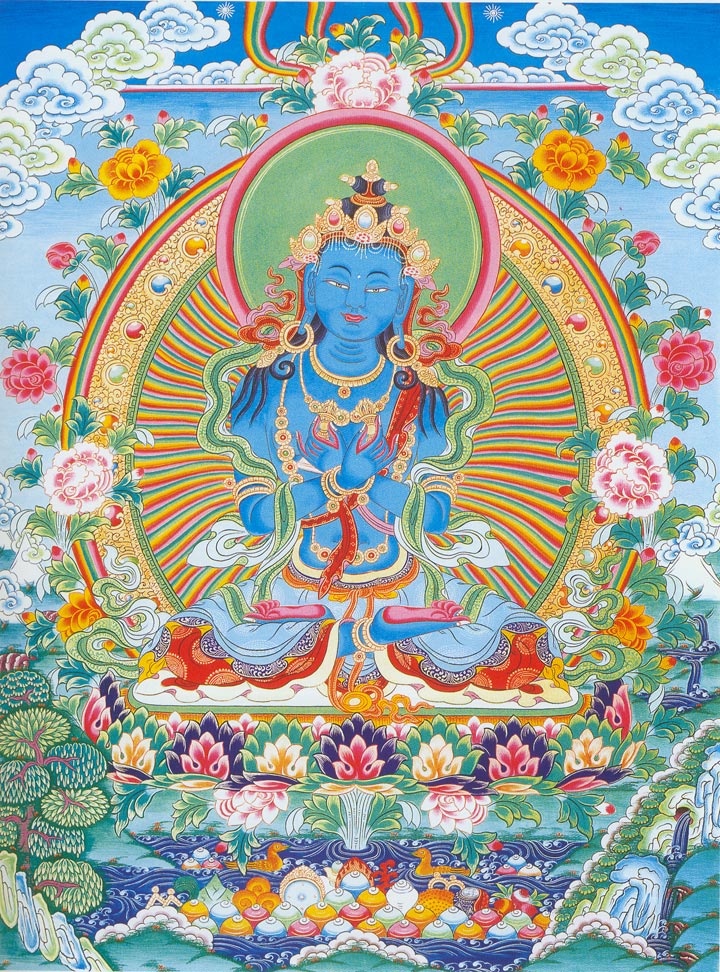Akaniแนฃแนญha on:
[Wikipedia]
[Google]
[Amazon]
In classical 
Buddhist Cosmology
Buddhist cosmology describes the planes and realms in which beings can be reborn. The spatial cosmology consists of a vertical cosmology, the various planes of beings, into which beings are reborn due to their merits and development; and a hori ...
, ''Akaniแนฃแนญha'' (Pali
Pali () is a Middle Indo-Aryan liturgical language native to the Indian subcontinent. It is widely studied because it is the language of the Buddhist ''Pฤli Canon'' or ''Tipiแนญaka'' as well as the sacred language of ''Theravฤda'' Buddhism ...
: ''Akaniแนญแนญha,'' meaning "Nothing Higher", "Unsurpassed") is the highest of the Pure Abodes
The ลuddhฤvฤsa (Pฤli: ; Tib: ) worlds, or "Pure Abodes", are distinct from the other worlds of the ' in that they do not house beings who have been born there through ordinary merit or meditative attainments, but only those Anฤgฤmins ("Non- ...
, and thus the highest of all the form realms. It is the realm where deva
Deva may refer to:
Entertainment
* ''Deva'' (1989 film), a 1989 Kannada film
* ''Deva'' (1995 film), a 1995 Tamil film
* ''Deva'' (2002 film), a 2002 Bengali film
* Deva (2007 Telugu film)
* ''Deva'' (2017 film), a 2017 Marathi film
* Deva ...
s like Maheลvara
Shiva (; sa, เคถเคฟเคต, lit=The Auspicious One, ลiva ), also known as Mahadeva (; Help:IPA/Sanskrit, ษษฆaหdฬชeหสษ, or Hara, is one of the Hindu deities, principal deities of Hinduism. He is the Supreme Being in Shaivism, one o ...
live.
In Mahayana
''Mahฤyฤna'' (; "Great Vehicle") is a term for a broad group of Buddhist traditions, texts, philosophies, and practices. Mahฤyฤna Buddhism developed in India (c. 1st century BCE onwards) and is considered one of the three main existing bra ...
Buddhism, Akaniแนฃแนญha is also a name for the Pure Land
A pure land is the celestial realm of a buddha or bodhisattva in Mahayana Buddhism. The term "pure land" is particular to East Asian Buddhism () and related traditions; in Sanskrit the equivalent concept is called a buddha-field (Sanskrit ). Th ...
(Buddhafield) of the Buddha
Siddhartha Gautama, most commonly referred to as the Buddha, was a ลramaแนa, wandering ascetic and religious teacher who lived in South Asia during the 6th or 5th century BCE and founded Buddhism.
According to Buddhist tradition, he was ...
Vairocana
Vairocana (also Mahฤvairocana, sa, เคตเฅเคฐเฅเคเคจ) is a cosmic buddha from Mahayana and Vajrayana Buddhism. Vairocana is often interpreted, in texts like the ''Avatamsaka Sutra'', as the dharmakฤya of the historical Gautama Buddha. In East ...
.

Tibetan Buddhism
Tibetan Buddhism (also referred to as Indo-Tibetan Buddhism, Lamaism, Lamaistic Buddhism, Himalayan Buddhism, and Northern Buddhism) is the form of Buddhism practiced in Tibet and Bhutan, where it is the dominant religion. It is also in majo ...
, Akaniแนฃแนญha (Tib. ''dharmadhatu
Dharmadhatu (Sanskrit) is the 'dimension', 'realm' or 'sphere' (dhฤtu) of the Dharma or Absolute Reality.
Definition
In Mahayana Buddhism, dharmadhฤtu ( bo, chos kyi dbyings; ) means "realm of phenomena", "realm of truth", and of the noumen ...
.
# The Densely Arrayed Akaniแนฃแนญha (Tib. ''Saแนbhogakฤya
''Saแนbhogakฤya'' ( sa, เคธเคเคญเฅเคเคเคพเคฏ lit. "body of enjoyment", zh, t=ๅ ฑ่บซ, p=bร oshฤn, Tib: ''longs spyod rdzog pa'i sku'') is the second mode or aspect of the Trikaya.
Definition
Celestial manifestations
''Sambhogakฤya'' is ...
Buddha field out of which emanate all Nirmฤแนakฤya
Nirmฤแนakฤya (Sanskrit; zh, t=ๆ่บซ, p=yฤซngshฤn; Tib. เฝฆเพคเพฒเฝดเฝฃเผเฝฆเพเฝดเผ, ''tulku'', Wyl. ''sprul sku'') is the third aspect of the trikฤya and the physical manifestation of a Buddha in time and space. In Vajrayฤna it is descr ...
Buddhas and Buddhafields such as Sukhฤvati. It is the supreme Buddhafield in which all Buddhas attain Buddhahood. The Saแนbhogakฤya Buddha Vajradhara
Vajradhara (Sanskrit: เคตเคเฅเคฐเคงเคฐ. (Also, the name of Indra, because 'Vajra' means diamond, as well as the thunderbolt, anything hard more generally) Tibetan: เฝขเพกเฝผเผเฝขเพเฝบเผเฝ เฝเฝเผ rdo rje 'chang (Dorje Chang); zh, t=้ๅ ...
is said to have taught the Vajrayana
Vajrayฤna ( sa, เคตเคเฅเคฐเคฏเคพเคจ, "thunderbolt vehicle", "diamond vehicle", or "indestructible vehicle"), along with Mantrayฤna, Guhyamantrayฤna, Tantrayฤna, Secret Mantra, Tantric Buddhism, and Esoteric Buddhism, are names referring t ...
in the realm of Akaniแนฃแนญha Ghanavyลซha.Changkya Rรถlpai Dorjรฉ, Donald Lopez (translator) (2019). ''Beautiful Adornment of Mount Meru'', chapter 13. Simon and Schuster.
# The Mundane Akaniแนฃแนญha, which is the highest pure level of the form realm, which is the sphere of nirmanakayas.
References
Pure lands {{cosmology-stub